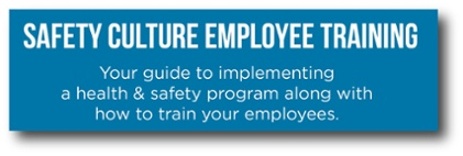 It's unfortunate. But the reality is that many safety initiatives fail to make a meaningful difference in the behaviors and safety of employees.
It's unfortunate. But the reality is that many safety initiatives fail to make a meaningful difference in the behaviors and safety of employees.
Below we'll cover the 3 most common failures, as well as the 8 steps to making safety stick at your company.
The 3 most common failures of safety initiatives
Failure #1: Not Sharing Accountability
Although it's powerful when accountability comes from people of authority, it's far more impactful when it comes from your peers. Give your employees the power and ability to speak up about unsafe acts by having a see something, say something, do something mentality.
One company I worked with implemented a safety glasses policy. We gave everyone one month to get it right and had a drop dead date of when it would be no longer tolerated if a person was seen without their glasses. However, well before this date even hit, employees were calling out those who did not have their glasses on and soon enough all were in compliance. Now, it's just a normal way of life and all employees wear their glasses on a consistent basis.
Failure #2: Make Safety a 'Strategic Initiative'
The C-Suite has many important things to work on. So it's tempting to delegate the 'safety initiative'. However, by doing so you are implicitly undermining the importance of safety at your company. And accordingly the results are never going to meet your expectations. Safety and loss metrics must have a place on the board.
A new c-suite executive joined a company I had been working with for quite some time. He wanted to cut expenses on things that didn't seem necessary and delegate all safety initiatives to his safety director. His theory - compliance = safety and it's not an area the c-suite should be involved in. He decided to stop purchasing locks for Lock Out/Tag Out - which left unattended, guardless machines not locked out and employees forgoing safety procedures because the new leader didn't see them as important. Investing in $10 locks had previously kept the company from getting million dollar claims for years, but this new leader did not understand the importance. Eventually, he learned the significance of safety as a financial strategy and has been deeply involved in its initiatives ever since.
Failure #3: Fail To Explain the WHY
Employees must understand the magnitude and impact of their actions. When people act in an unsafe way, they are usually only contemplating the direct impact of that behavior on themselves.
However, when an accident occurs it's far more than just damaged property or an insurance claim. The impact to the company can be severe enough to cause people to lose their jobs. But most importantly, the human impact to their family and their community can be devastating.
Let's focus solely on the financial impact. An employee decides to not wear a seat belt while operating a forklift. The forklift tips and severely injures that worker. Not only are they hurt directly, but now your company needs to find a person to step in while the injured employee is on worker's comp. Additionally, the forklift needs to be repaired along with damage to other components in your shop. Not only is an insurance claim made, but your MOD increases. Your cost of insurance goes up, and maybe there's less money available for employee profit sharing or bonuses. Or maybe you lose your biggest contract because you no longer meet their safety requirements and can't bid competitively. The domino effect continues and costs add up.
See how Poblocki Paving implemented risk ownership into their safety culture.
The 8 steps to making safety stick
1. Establish baseline expectations of safety.
Set clear expectations for safety and be unwavering when it comes to those who compromise on them. This includes everyone!
2. Communicate this baseline with all levels of employees and management.
Communicate clearly to all levels of employees what these standards are and the repercussions for those who compromise them. This includes the HOW and the WHY.
3. Encourage empowerment and allow all employees to be a safety ambassador.
Set a see something, say something, do something expectation. Employees who feel empowered to speak up about unsafe acts make a safe environment everyone's responsibility.
4. Provide consistent follow up and feedback.
Safety should be talked about, and often. Make safety initiatives part of your day-to-day conversations as well as a performance metric at employee reviews.
5. Celebrate the wins while addressing the losses.
Reward employees for keeping their workplace safe, but also make sure to call out the losses. At company meetings, make this a major topic of conversation.
6. Liberate the safety director of enforcement and allow the senior leaders to be the safety champions.
Put your senior leaders in control of making your work environment safe. Safety Directors can't be everywhere all the time. Allowing management to champion safety will ensure more eyes on the lookout for unsafe acts.
7. Implement risk ownership ideals.
This starts with the right communication from leadership. Not only is safety following protocol, but it is about employee values and how they view workplace risk.
8. Always chase the moving target. Safety is evolving, so your culture should be as well.
Like your business, safety is ever-changing. Re-evaluate your safety initiatives each year to make sure you are ready for what's next.
.png?width=69&height=53&name=Acrisure%20Logo%20(White%20Horizontal).png)


